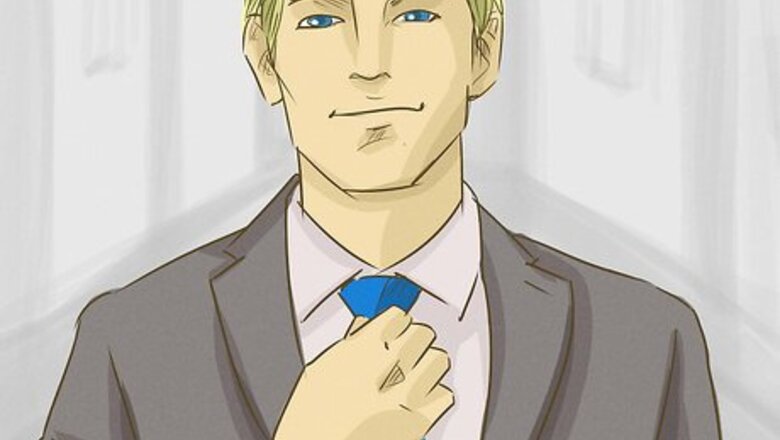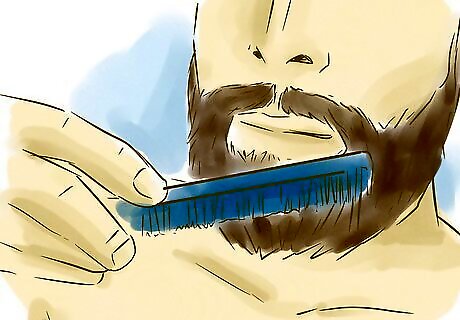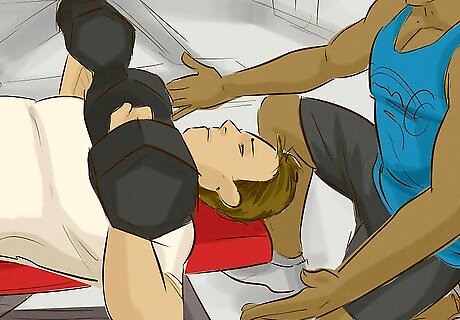
views
Adopting a Masculine Mindset

Project confidence through your body language and behavior. Men are traditionally taken more seriously and treated with more respect when they display confidence. While confidence is a gender-neutral trait that benefits anyone, a lot of confident body language is associated with masculinity. For example, you might think about sitting back with your shoulders wide and your legs spread—a posture often referred to as "manspreading" precisely because of its association with men. Part of being confident is accepting compliments graciously without apologizing or diminishing the compliment—for example, by simply saying "Thanks, I appreciate that" rather than "Oh, this old thing?". Practice asking for what you want and acknowledging your abilities, rather than just going along with whatever the other person wants.

Take more calculated risks in life. Studies show that men tend to take more risks than women do, so risk-taking is often considered a masculine way of moving through the world. It also takes a lot of confidence to take risks, so these traditionally masculine traits tend to reinforce themselves. Sometimes this looks like reckless behavior for its own sake, but that isn't necessarily what you want. Instead, think about not backing down from making the smartest choice, even if it's kind of scary. When you take bold steps to get where you want to be, it shows that you believe in yourself and aren't timid about pursuing your goals or advancing relationships. If taking risks is something that causes you trouble, start with small things that won't really make any difference in your life regardless of the outcome. Then, start working your way up to taking more meaningful risks.

Maintain a tough, emotionless exterior. This doesn't truly mean that you have no emotions. Rather, you maintain an unruffled appearance and don't get bent out of shape when something doesn't go your way. You're willing to let things go and don't constantly try to rehash issues or hold grudges. Think of the toughness as something you can moderate and soften when it's necessary to avoid coming across as robotic. Keep in mind that this tough shell is also associated with toxic masculinity. While you might appear emotionless on the surface, it's much more healthy to release your emotions than to bottle them up or hide them away. It can help to think of this more in terms of remaining calm and composed during stressful times. This is the type of person people depend on to lead them, and it's something associated with masculinity in many cultures.

Take responsibility for your own upkeep. Men are far more associated with individualism and independence than women are. Being responsible and capable of managing your life on your own is often seen as a somewhat masculine trait. The biggest set of circumstances in which this sort of thing would apply would be if you lived alone and paid all of your own bills rather than living with your family or with roommates. Communal or familial living arrangements, along with being more interdependent on other people, are more typically associated with femininity.

Set goals and achieve them. Men are traditionally seen as being goal-oriented and focused on achievement. If you're able to set goals for your life and execute all of the tasks it takes to reach them, people will often see this as a relatively masculine trait. Setting goals is beneficial for anyone, regardless of your gender expression. But if you have a goal-oriented mindset, you can even apply it to your quest to become more masculine and celebrate the results. Setting goals also allows you to demonstrate another masculine trait—being calm and rational when you're faced with an unexpected hurdle.

Fight against toxic masculinity. Presenting masculine involves playing around with some stereotypes about manliness that can be harmful. Take the time to understand the harmful side of these stereotypes. By speaking out against toxic masculinity you can avoid the more misogynistic parts of embracing your masculinity. Think about the version of masculinity you want to project. Leave off anything that doesn't fit in with that image in your head. Many masculine traits are just fine as long as they're restricted to a particular context. For example, if you're a naturally competitive person, sports and games are a great way to scratch that itch in a healthy way (rather than trying to dominate people around you).

Express your emotions in healthy ways. One of the most stubborn stereotypes about boys and men is that it's not manly or masculine to cry. On the contrary, if you let your feelings out in healthy, productive ways, you'll find it easier to process your emotions and bounce back after difficulties. Modeling the expression of emotions in healthy ways is incredibly important for anyone presenting masculine who wants to combat the ill effects of toxic masculinity. Remember that others are looking to you, particularly younger people who are looking for clues on what is and isn't masculine.
Acting More Masculine

Share your opinion more frequently. The stereotype is that men aren't shy about speaking up. While it's certainly true that there are men who are naturally timid, being outspoken and direct is typically associated with masculinity. If you're willing to speak your mind and aren't worried about potentially making a mistake or stepping on someone's toes, you'll come across as more masculine. For example, Hillary Clinton once said, "I don't have a traditionally female way of speaking... I'm quite assertive. If I didn't speak the way I do, I wouldn't have been seen as a leader." Being direct and outspoken doesn't mean that you're interrupting or talking over other people—practicing active listening and considering other viewpoints are important leadership qualities associated with manliness.

Be assertive when communicating your thoughts. Society typically associates assertiveness and straightforwardness with masculinity. You'll seem more masculine if you don't apologize for yourself or draw attention to your mistakes. This also means not overthinking or expressing any self-doubts out loud. Any lack of assurance you have, keep it to yourself. If you're seen as someone who knows what they're talking about, people will often be less likely to challenge what you say. You'll come across as having power and authority, both of which are traditionally considered masculine traits. When you know you're right about something, it's usually best to state your case and move on. There's no point in getting into a discussion or debate about it. If you get something wrong, simply correct it and move on. Apologizing and being overly considerate of others' feelings are typically considered feminine traits.

Crack more jokes to break the ice. Humor, as it turns out, is a very gendered phenomenon. Generally speaking, men want others to appreciate their humor while women want someone who will make them laugh. So if you want to seem more masculine, simply make humorous observations or one-liners to get those around you to laugh. Humor can be more beneficial to you if you present as masculine as well. For example, one study showed that people tend to associate men who use humor during business presentations as having higher levels of status.
Stay in tune with your core values. Your core values define who you are and guide everything you do. When you take time to clearly define your core values, you're able to move through your life with strength and purpose. Everyone has a mix of traits that are considered masculine, feminine, or neutral—and those can change throughout a person's lifetime or when they move to a different place. Focus on having the most authentic gender expression for you. Your core values also give you focus and make it easier to make decisions—you simply act in alignment with your core values. Others will find you more steadfast and reliable, both of which are traditionally considered masculine traits.

Take on a more stereotypically masculine hobby. The effectiveness of your gender presentation depends a lot on what people think of you. If you have a stereotypically masculine hobby, people often tend to see you as more masculine. And if your hobby is one that you actually have a passion for, even better! Hunting, fishing, and the outdoors are all traditionally masculine hobbies that can be fairly cheap and easy to get into. This isn't any sort of requirement, but can help reinforce your own feelings of masculinity. If you're not into those sorts of things and wouldn't have fun doing them, don't sweat it!
Looking More Masculine

Dress in traditional men's clothing. If you want to look more masculine, focus on timeless pieces of clothing in classic designs. These fashion staples never go out of style and will easily contribute to your masculine presentation. For example, in Western countries, a traditionally masculine look usually involves fairly loose-fitting durable or active clothing in neutral or darker tones with few accessories. Observe your masculine friends and ask them for advice if you're not sure where to start or which pieces you should include in your wardrobe.

Cut your hair and grow facial hair if you can. In many cultures, masculinity is associated with a short haircut, so chopping your hair off (or even buzzing it, if you're feeling bold) can get you some major manly points. Facial hair can also help emphasize more masculine facial lines. You can also use makeup to make your facial features look more masculine or create the appearance of facial hair. It's worth noting that makeup itself has, for most of its existence, been considered gender-neutral (and in some cultures, it still is). Don't use a more masculine look as an excuse to slack on your personal hygiene. While you might not want to shower often enough that you still give off a little natural odor, you still want to make sure you're showering frequently enough to stay clean.

Bind your chest if necessary. Breasts are traditionally associated with femininity, so not having them is a pretty quick way to look more masculine. Wearing a binder can help you become more masculine if your breasts don't line up with your gender identity or cause you dysphoria or discomfort. Avoid wearing your binder for hours on end or for several days in a row. Give your body a chance to heal from the trauma so you don't unintentionally disfigure or injure yourself. Wearing baggy clothes that hide your curves can also make a huge difference in both your presentation and your comfort level. Avoid using ace bandages, which can cause internal injuries, or tape, which doesn't move with your body and can cause serious damage.

Adopt a manly swagger. Your posture and the way you carry yourself are a huge part of presenting more masculine. Walk quickly and with purpose, looking straight ahead of you and keeping your eyes active and alert. Be quick to smile and greet people with a nod or a handshake. Try to keep calm and composed in public. Fidgeting or shifting positions frequently is typically not considered very masculine.

Start a strength-training regimen. There are plenty of men who live a relatively sedentary lifestyle. Even so, being strong and physically active is something commonly associated with masculinity. You can also focus your weight training to give your body a more masculine shape over time by emphasizing some areas and de-emphasizing others. Being in control is a big part of being masculine, and your body is one of the things that you want to have control over. Pride in your body and what it can do will also help boost your confidence. If you're not much of a gym rat, you might try picking up a new sport instead. The point is simply to be active and athletic.



















Comments
0 comment